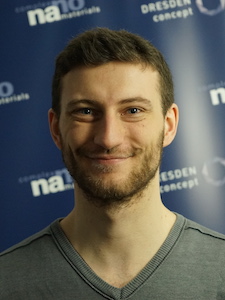


The Hofstadter’s Butterfly is one of the first and most fascinating examples of the fractal and self-similar quantum nature of free electrons in a lattice. Interestingly enough, its discovery was computationally obtained by Douglas Hofstadter already in 1976 by piercing with a magnetic field an ideal 2D square lattice [1]: The fractal plot of the allowed electronic states vs the intensity of the perpendicular magnetic field was soon after christened as the Hofstadter’s Butterfly (HB). The HB encodes most exotic behaviors of quantum mechanics and topology, namely the quantum Hall effect and the conductance quantization which were then discovered in 1980s’. The fascination for the HB was then revived by the experimental isolation of 2D materials such as graphene: Although many exotic and very peculiar effects can be observed already at small magnetic fields [2,3], to observe an entire HB in a graphene layer, it is necessary to collect a single magnetic flux quantum within the area of a benzene ring, corresponding to a field of 79,000 T! For this reason, its experimental verification has only been realized in artificial periodic 2D systems, like Moiré lattices. This relegated the HB to a very peculiar physical divertissement for mainly theoretical interests. We propose here 2D covalent-organic frameworks (COFs) as the first pure materials for a direct experimental verification of the HB. Due to their large pore structures, the magnetic fields needed to measure most features of a HB are accessible in today's experiments. 2D COFs can thus turn this once-theoretical issue from the 70s into experimental reality and solve the quest for its proof in pure materials. Moreover, the intrinsic hierarchy of pores and the possibility to thread different fluxes at different pore scales adds to the COFs HB additional important structures which will be amply discussed in this talk.
[1] D. R. Hofstadter, Phys. Rev. B 14, 2239 (1976).
[2] N. Nemec et. al, Phys. Rev B 74, 165411 (2006).
[3] N. Nemec et. al, Phys. Rev B 75, 201404 (2007).
[4] S. Hahn et. al, Nature 570, 496 (2019).



The Hofstadter’s Butterfly is one of the first and most fascinating examples of the fractal and self-similar quantum nature of free electrons in a lattice. Interestingly enough, its discovery was computationally obtained by Douglas Hofstadter already in 1976 by piercing with a magnetic field an ideal 2D square lattice [1]: The fractal plot of the allowed electronic states vs the intensity of the perpendicular magnetic field was soon after christened as the Hofstadter’s Butterfly (HB). The HB encodes most exotic behaviors of quantum mechanics and topology, namely the quantum Hall effect and the conductance quantization which were then discovered in 1980s’. The fascination for the HB was then revived by the experimental isolation of 2D materials such as graphene: Although many exotic and very peculiar effects can be observed already at small magnetic fields [2,3], to observe an entire HB in a graphene layer, it is necessary to collect a single magnetic flux quantum within the area of a benzene ring, corresponding to a field of 79,000 T! For this reason, its experimental verification has only been realized in artificial periodic 2D systems, like Moiré lattices. This relegated the HB to a very peculiar physical divertissement for mainly theoretical interests. We propose here 2D covalent-organic frameworks (COFs) as the first pure materials for a direct experimental verification of the HB. Due to their large pore structures, the magnetic fields needed to measure most features of a HB are accessible in today's experiments. 2D COFs can thus turn this once-theoretical issue from the 70s into experimental reality and solve the quest for its proof in pure materials. Moreover, the intrinsic hierarchy of pores and the possibility to thread different fluxes at different pore scales adds to the COFs HB additional important structures which will be amply discussed in this talk.
[1] D. R. Hofstadter, Phys. Rev. B 14, 2239 (1976).
[2] N. Nemec et. al, Phys. Rev B 74, 165411 (2006).
[3] N. Nemec et. al, Phys. Rev B 75, 201404 (2007).
[4] S. Hahn et. al, Nature 570, 496 (2019).